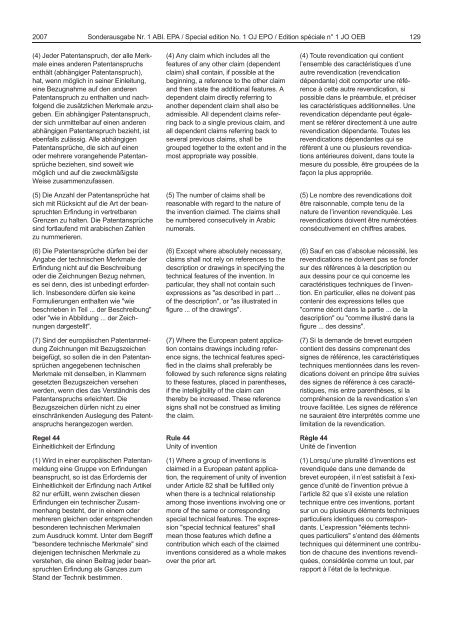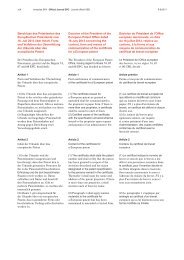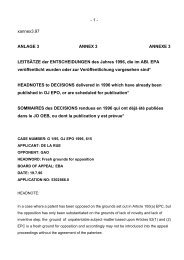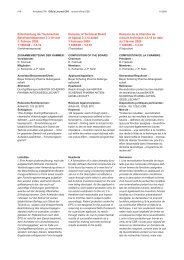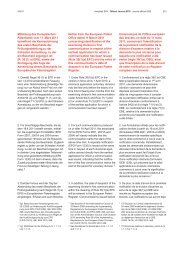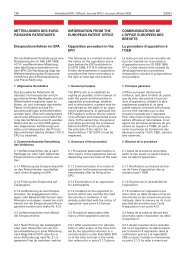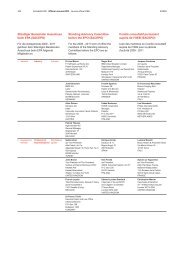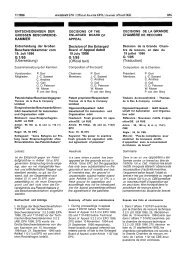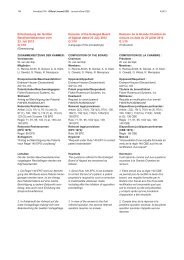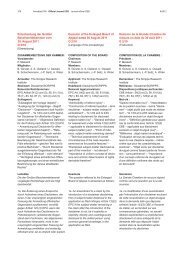Sonderausgabe 1 - European Patent Office
Sonderausgabe 1 - European Patent Office
Sonderausgabe 1 - European Patent Office
You also want an ePaper? Increase the reach of your titles
YUMPU automatically turns print PDFs into web optimized ePapers that Google loves.
2007 <strong>Sonderausgabe</strong> Nr. 1 ABl. EPA / Special edition No. 1 OJ EPO / Edition spéciale n° 1 JO OEB 129<br />
(4) Jeder <strong>Patent</strong>anspruch, der alle Merkmale<br />
eines anderen <strong>Patent</strong>anspruchs<br />
enthält (abhängiger <strong>Patent</strong>anspruch),<br />
hat, wenn möglich in seiner Einleitung,<br />
eine Bezugnahme auf den anderen<br />
<strong>Patent</strong>anspruch zu enthalten und nachfolgend<br />
die zusätzlichen Merkmale anzugeben.<br />
Ein abhängiger <strong>Patent</strong>anspruch,<br />
der sich unmittelbar auf einen anderen<br />
abhängigen <strong>Patent</strong>anspruch bezieht, ist<br />
ebenfalls zulässig. Alle abhängigen<br />
<strong>Patent</strong>ansprüche, die sich auf einen<br />
oder mehrere vorangehende <strong>Patent</strong>ansprüche<br />
beziehen, sind soweit wie<br />
möglich und auf die zweckmäßigste<br />
Weise zusammenzufassen.<br />
(5) Die Anzahl der <strong>Patent</strong>ansprüche hat<br />
sich mit Rücksicht auf die Art der beanspruchten<br />
Erfindung in vertretbaren<br />
Grenzen zu halten. Die <strong>Patent</strong>ansprüche<br />
sind fortlaufend mit arabischen Zahlen<br />
zu nummerieren.<br />
(6) Die <strong>Patent</strong>ansprüche dürfen bei der<br />
Angabe der technischen Merkmale der<br />
Erfindung nicht auf die Beschreibung<br />
oder die Zeichnungen Bezug nehmen,<br />
es sei denn, dies ist unbedingt erforderlich.<br />
Insbesondere dürfen sie keine<br />
Formulierungen enthalten wie "wie<br />
beschrieben in Teil ... der Beschreibung"<br />
oder "wie in Abbildung ... der Zeichnungen<br />
dargestellt".<br />
(7) Sind der europäischen <strong>Patent</strong>anmeldung<br />
Zeichnungen mit Bezugszeichen<br />
beigefügt, so sollen die in den <strong>Patent</strong>ansprüchen<br />
angegebenen technischen<br />
Merkmale mit denselben, in Klammern<br />
gesetzten Bezugszeichen versehen<br />
werden, wenn dies das Verständnis des<br />
<strong>Patent</strong>anspruchs erleichtert. Die<br />
Bezugszeichen dürfen nicht zu einer<br />
einschränkenden Auslegung des <strong>Patent</strong>anspruchs<br />
herangezogen werden.<br />
Regel 44<br />
Einheitlichkeit der Erfindung<br />
(1) Wird in einer europäischen <strong>Patent</strong>anmeldung<br />
eine Gruppe von Erfindungen<br />
beansprucht, so ist das Erfordernis der<br />
Einheitlichkeit der Erfindung nach Artikel<br />
82 nur erfüllt, wenn zwischen diesen<br />
Erfindungen ein technischer Zusammenhang<br />
besteht, der in einem oder<br />
mehreren gleichen oder entsprechenden<br />
besonderen technischen Merkmalen<br />
zum Ausdruck kommt. Unter dem Begriff<br />
"besondere technische Merkmale" sind<br />
diejenigen technischen Merkmale zu<br />
verstehen, die einen Beitrag jeder beanspruchten<br />
Erfindung als Ganzes zum<br />
Stand der Technik bestimmen.<br />
(4) Any claim which includes all the<br />
features of any other claim (dependent<br />
claim) shall contain, if possible at the<br />
beginning, a reference to the other claim<br />
and then state the additional features. A<br />
dependent claim directly referring to<br />
another dependent claim shall also be<br />
admissible. All dependent claims referring<br />
back to a single previous claim, and<br />
all dependent claims referring back to<br />
several previous claims, shall be<br />
grouped together to the extent and in the<br />
most appropriate way possible.<br />
(5) The number of claims shall be<br />
reasonable with regard to the nature of<br />
the invention claimed. The claims shall<br />
be numbered consecutively in Arabic<br />
numerals.<br />
(6) Except where absolutely necessary,<br />
claims shall not rely on references to the<br />
description or drawings in specifying the<br />
technical features of the invention. In<br />
particular, they shall not contain such<br />
expressions as "as described in part ...<br />
of the description", or "as illustrated in<br />
figure ... of the drawings".<br />
(7) Where the <strong>European</strong> patent application<br />
contains drawings including reference<br />
signs, the technical features specified<br />
in the claims shall preferably be<br />
followed by such reference signs relating<br />
to these features, placed in parentheses,<br />
if the intelligibility of the claim can<br />
thereby be increased. These reference<br />
signs shall not be construed as limiting<br />
the claim.<br />
Rule 44<br />
Unity of invention<br />
(1) Where a group of inventions is<br />
claimed in a <strong>European</strong> patent application,<br />
the requirement of unity of invention<br />
under Article 82 shall be fulfilled only<br />
when there is a technical relationship<br />
among those inventions involving one or<br />
more of the same or corresponding<br />
special technical features. The expression<br />
"special technical features" shall<br />
mean those features which define a<br />
contribution which each of the claimed<br />
inventions considered as a whole makes<br />
over the prior art.<br />
(4) Toute revendication qui contient<br />
l’ensemble des caractéristiques d’une<br />
autre revendication (revendication<br />
dépendante) doit comporter une référence<br />
à cette autre revendication, si<br />
possible dans le préambule, et préciser<br />
les caractéristiques additionnelles. Une<br />
revendication dépendante peut également<br />
se référer directement à une autre<br />
revendication dépendante. Toutes les<br />
revendications dépendantes qui se<br />
réfèrent à une ou plusieurs revendications<br />
antérieures doivent, dans toute la<br />
mesure du possible, être groupées de la<br />
façon la plus appropriée.<br />
(5) Le nombre des revendications doit<br />
être raisonnable, compte tenu de la<br />
nature de l’invention revendiquée. Les<br />
revendications doivent être numérotées<br />
consécutivement en chiffres arabes.<br />
(6) Sauf en cas d’absolue nécessité, les<br />
revendications ne doivent pas se fonder<br />
sur des références à la description ou<br />
aux dessins pour ce qui concerne les<br />
caractéristiques techniques de l’invention.<br />
En particulier, elles ne doivent pas<br />
contenir des expressions telles que<br />
"comme décrit dans la partie ... de la<br />
description" ou "comme illustré dans la<br />
figure ... des dessins".<br />
(7) Si la demande de brevet européen<br />
contient des dessins comprenant des<br />
signes de référence, les caractéristiques<br />
techniques mentionnées dans les revendications<br />
doivent en principe être suivies<br />
des signes de référence à ces caractéristiques,<br />
mis entre parenthèses, si la<br />
compréhension de la revendication s’en<br />
trouve facilitée. Les signes de référence<br />
ne sauraient être interprétés comme une<br />
limitation de la revendication.<br />
Règle 44<br />
Unité de l’invention<br />
(1) Lorsqu’une pluralité d’inventions est<br />
revendiquée dans une demande de<br />
brevet européen, il n’est satisfait à l’exigence<br />
d’unité de l’invention prévue à<br />
l’article 82 que s’il existe une relation<br />
technique entre ces inventions, portant<br />
sur un ou plusieurs éléments techniques<br />
particuliers identiques ou correspondants.<br />
L’expression "éléments techniques<br />
particuliers" s’entend des éléments<br />
techniques qui déterminent une contribution<br />
de chacune des inventions revendiquées,<br />
considérée comme un tout, par<br />
rapport à l’état de la technique.


